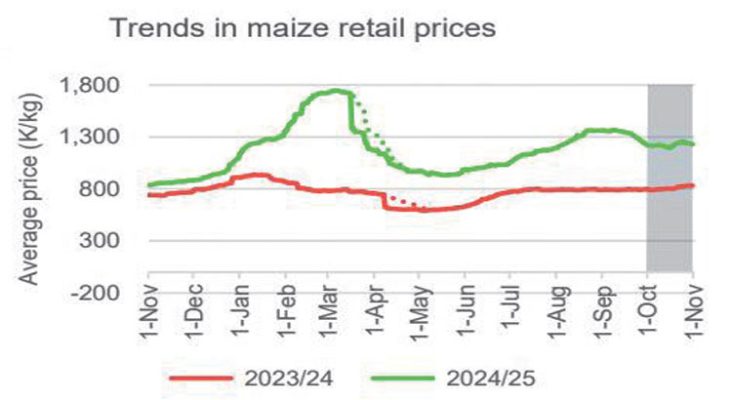
Stabilizing Maize Prices: A Catalyst for Malawi’s Economic Growth
Key Business Points
- Maize prices have dropped by 2% in October 2025, with the national average recorded at K1,240 per kilogram, providing temporary relief to consumers and businesses.
- Timely and transparent maize imports are crucial to sustain the easing of maize prices and prevent speculation and panic in the market, according to experts.
- Food market landscape remains unstable, with the minimum survival cost for a low-income household increasing by 0.72% in October, highlighting the need for sustained efforts to address food pressures and inflation.
The recent drop in maize prices in Malawi has brought some relief to consumers and businesses, but experts warn that the food market landscape remains highly unstable. According to the International Food Policy Research Institute (Ifpri) Maize Market Report for October 2025, the grain’s retail price dropped by 2% in October, building on the trend observed post-September 16 General Elections. This trend is attributed to a mix of factors, including post-election uncertainties, government import plans, and cheaper imports due to currency gains.
However, despite this drop, the overall cost of living has not decreased, with the minimum survival cost for a low-income household rising by 0.72% in October. Centre for Social Concern economic governance programmes officer Agnes Nyirongo notes that the easing of maize prices is a temporary relief emanating from government maize imports and election-induced market speculation. To sustain the recent easing of maize prices, Nyirongo emphasizes the need for timely and transparent execution of maize imports to prevent speculation and panic.
The Consumers Association of Malawi executive director, John Kapito, believes that the drop in maize prices will push inflation down, although it is too early to see significant benefits. Meanwhile, Economics Association of Malawi president, Bertha Bangara-Chikadza, highlights the country’s underlying food pressures that need to be addressed through importation of maize. The government’s plan to import 200,000 metric tonnes of maize through Admarc Limited could continue to improve maize supply and further reduce the grain’s prices and food inflation.
As inflation trends remain a concern, with a recorded rate of 29.1% in October 2025, up from 28.7% in September, businesses and entrepreneurs must stay informed about market developments and adjust their strategies accordingly. In Chichewa, this is known as "kuganiza kwa njira ya mtengero", or adapting to changing market conditions. By doing so, they can capitalize on opportunities and mitigate risks in the dynamic Malawian market. With the Reserve Bank of Malawi projecting the inflation rate to average 28.9% this year, businesses must remain vigilant and proactive in their pricing and investment decisions.
What are your thoughts on this business development? Share your insights and remember to follow us on Facebook and Twitter for the latest Malawi business news and opportunities. Visit us daily for comprehensive coverage of Malawi’s business landscape.
- Stabilizing Maize Prices: A Catalyst for Malawi’s Economic Growth - November 21, 2025
- Powering Growth: Egenco Revitalizes Nkula Station, Energizes Malawi’s Economy - November 21, 2025
- Revitalizing Malawi’s Economy: B20 South Africa 2025 Ignites New Opportunities for Growth and Prosperity - November 21, 2025
